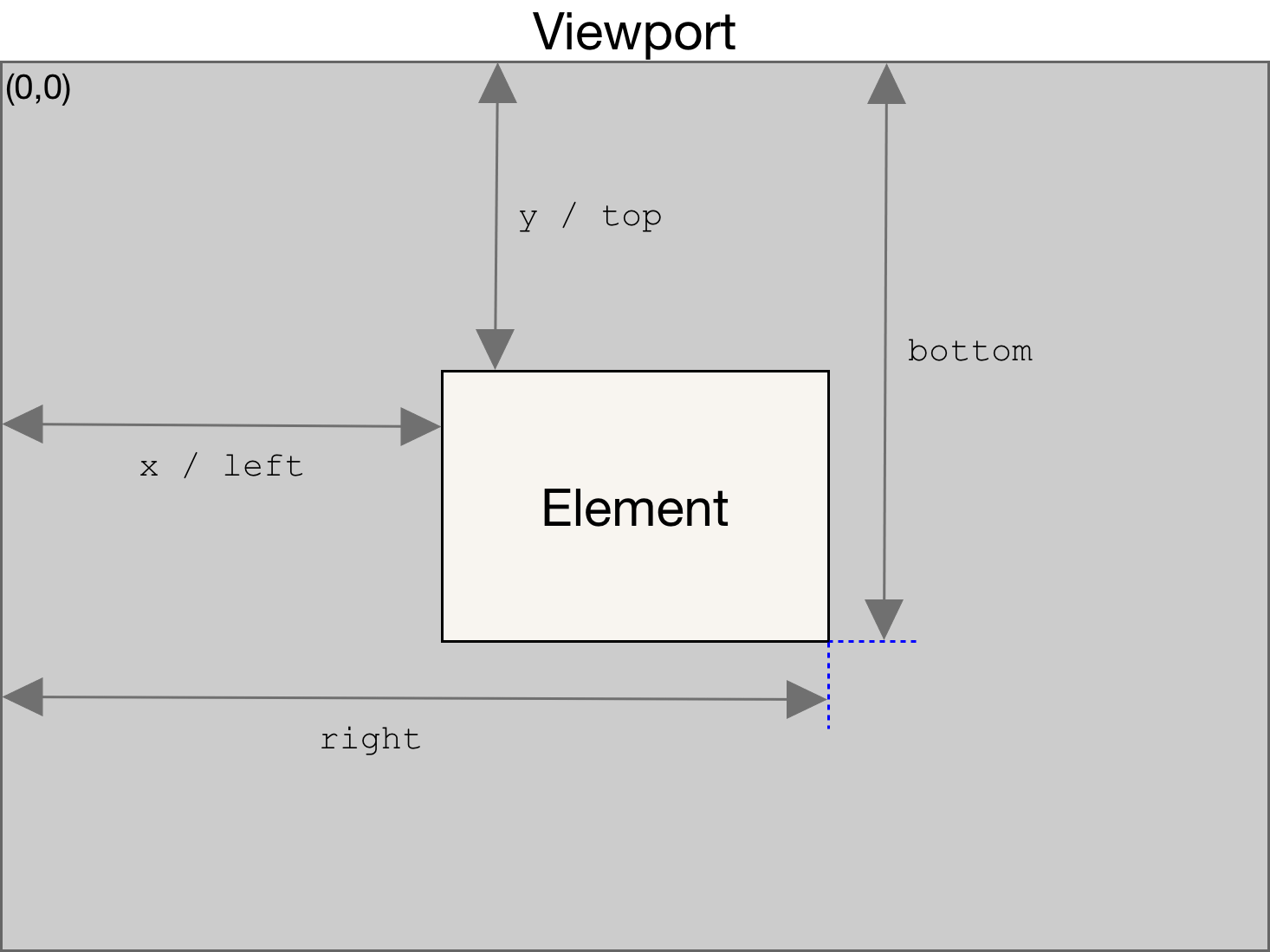Element: getBoundingClientRect() Methode
Baseline
Widely available
This feature is well established and works across many devices and browser versions. It’s been available across browsers since Juli 2015.
Die Element.getBoundingClientRect() Methode gibt ein
DOMRect Objekt zurück, das Informationen über die Größe eines Elements und seine
Position relativ zum Viewport bereitstellt.
Syntax
getBoundingClientRect()
Parameter
Keine.
Rückgabewert
Der zurückgegebene Wert ist ein DOMRect Objekt, welches das kleinste Rechteck ist,
das das gesamte Element einschließlich seines Innenabstands (padding) und Randbreite (border-width) enthält. Die
Eigenschaften left, top, right, bottom,
x, y, width und height beschreiben die Position und Größe des gesamten Rechtecks in Pixeln. Andere Eigenschaften als
width und height sind relativ zur oberen linken Ecke des Viewports.

Die width und height Eigenschaften des DOMRect
Objekts, das von der Methode zurückgegeben wird, beinhalten den padding und
border-width, nicht nur die Inhaltsbreite/-höhe. Im Standard-Box-Modell
entspräche dies der width oder height Eigenschaft des
Elements + padding + border-width. Aber wenn box-sizing: border-box für das Element gesetzt ist, wäre dies direkt gleich seiner width oder
height.
Der zurückgegebene Wert kann als die Vereinigung der Rechtecke betrachtet werden, die durch
getClientRects() für das Element zurückgegeben werden, d.h. die CSS
Border-Boxen, die mit dem Element assoziiert sind.
Leere Border-Boxen werden komplett ignoriert. Wenn alle Border-Boxen des Elements leer sind,
wird ein Rechteck mit einer width und height von Null
zurückgegeben, wobei die top und left der oberen linken Ecke der Border-Box
für die erste CSS-Box (in Inhaltsreihenfolge) des Elements entspricht.
Der Scrollbetrag, der im Viewport-Bereich (oder einem anderen
scrollbaren Element) erfolgt ist, wird beim Berechnen des Begrenzungsrechtecks berücksichtigt. Das
bedeutet, dass sich die Begrenzungskanten des Rechtecks (top, right,
bottom, left) jedes Mal ändern, wenn sich die Scrollposition ändert (da ihre Werte relativ zum Viewport und nicht absolut sind).
Wenn Sie das Begrenzungsrechteck relativ zur oberen linken Ecke des Dokuments benötigen,
addieren Sie einfach die aktuelle Scrollposition zu den top und left
Eigenschaften (diese können mit window.scrollY und
window.scrollX ermittelt werden), um ein Begrenzungsrechteck zu erhalten, das unabhängig von der
aktuellen Scrollposition ist.
Beispiele
Grundlegend
Dieses einfache Beispiel ruft das DOMRect Objekt ab, das das Begrenzungsrechteck
eines einfachen <div> Elements darstellt, und gibt seine Eigenschaften
unterhalb davon aus.
<div></div>
div {
width: 400px;
height: 200px;
padding: 20px;
margin: 50px auto;
background: purple;
}
let elem = document.querySelector("div");
let rect = elem.getBoundingClientRect();
for (const key in rect) {
if (typeof rect[key] !== "function") {
let para = document.createElement("p");
para.textContent = `${key} : ${rect[key]}`;
document.body.appendChild(para);
}
}
Beachten Sie, wie die width/height gleich ihrer
width/height + padding sind.
Beachten Sie auch, wie die Werte von x/left,
y/top, right und bottom gleich dem absoluten Abstand vom relevanten Rand des Viewports zu
dieser Seite des Elements sind, in jedem Fall.
Scrollen
Dieses Beispiel demonstriert, wie sich das Begrenzungsrechteck verändert, wenn das Dokument gescrollt wird.
<div id="example"></div>
<div id="controls"></div>
div#example {
width: 400px;
height: 200px;
padding: 20px;
margin: 50px auto;
background: purple;
}
body {
padding-bottom: 1000px;
}
p {
margin: 0;
}
function update() {
const container = document.getElementById("controls");
const elem = document.getElementById("example");
const rect = elem.getBoundingClientRect();
container.textContent = "";
for (const key in rect) {
if (typeof rect[key] !== "function") {
let para = document.createElement("p");
para.textContent = `${key} : ${rect[key]}`;
container.appendChild(para);
}
}
}
document.addEventListener("scroll", update);
update();
Spezifikationen
| Specification |
|---|
| CSSOM View Module # dom-element-getboundingclientrect |